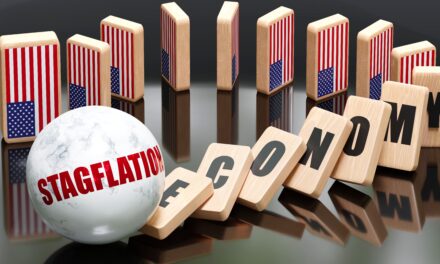President Trump’s transformative new agenda has thrown a serious curveball at markets, investors and the economy at large.
So far, so good. We’ve currently got stocks surging to new highs and strong economic activity pointing towards a resilient US economy at large.
But once we start to dig a little deeper, you’ll see that there’s a systemwide slowdown in consumer spending across the board. And it seems like it’s just getting started:
Video transcript:
Hello fellow Moneyball economists, I’m Andrew Zatlin and this is Moneyball Economics.
The topic today is the US consumer. The reason? Well, 70% of our economy is driven by consumer spending. So whether you’re in the stock market or in the bond market and wondering what the Fed’s going to do with interest rates, it all comes back to the US consumer.
And guess what? Next week we get a snapshot of consumer spending in the form of the retail data. So, we get the May spending retail data, and that’s our best view of what’s going on with the consumer.
Cut to the chase — I expect a lot of downside surprise, and I want to talk about what the implications are if I’m correct. But let’s start off academically.
We know we care about US consumers and what we find is that the US consumer spends every dollar that comes in, they’re not really good savers, okay? So academically, wages are growing about just shy of 4 – 5%. Economists look at that, they divide by 12 pretty much, and they say, “oh, if the US consumer spends gets four and a half percent more money every year and they spend it, then retail should go up basically in a relationship of about 0.3 to 0.4% per month on a month over month basis.” You add it up, boom, there we go.
So most economists use as their baseline for looking at the retail number of 0.3 or 0.4% month over month. And then you factor in all these things that could shift it. Typically there are external shocks, like it might be bad storms. You get a really nasty hurricane, well, you’re pushing out a lot of local, say food service spending. People don’t like to go out when it’s raining and when it’s stormy.
On the other hand, it could drive more building material sales in the next month because you got to rebuild homes and so on and so forth.
So you start factoring in all these external shocks, and guess what? The US consumer this year has faced some pretty big shocks in the form of what I call the President Trump snow globe effect. So Trump comes in and man, he is just swinging, swinging away. He’s in Washington D.C. and he’s swinging away on government spending, which by the way, spills into the private sector. When you start cutting contracts, he’s laying off people.
Oh, then we’ve got the tariffs and then we’ve got deportations. Trump is taking a snow globe and he’s shaking it violently. And that startles Wall Street. So the chain of events is this, got that snow globe being shaken up. Wall Street panics, boom. Next thing you know, your 401(k) is down 15%.
So if you’re sitting here in March, in April, you see your 401(k) dropping, you were about to buy a car or maybe you were going to do a big home project, or heck, maybe you were about to buy a home, but the assets you were going to draw on your four, your 401(k), that’s down 15%.
So you’re starting to think about pushing out that spending maybe delaying it. And this is why I said we will see a recession in the second half if Trump doesn’t let things settle down.
Why? Because most of the spending in the summertime tickets to go on vacation and hotels, that’s already been factored in. You’re not really drawing on your 401(k), but if you get to May and things are still dicey, you’re going to throw in the towel.
Well, this is the March/April scenario versus May because as we know in May that snow globe effect, it’s settling down, everything’s calming down, stock markets rebounded. In fact, your 401(k) is pretty much back to where it was. And layoffs … you haven’t really seen a lot of layoffs out there. So your wages are still steady eddie. And tariff inflation, you’re not seeing any of that. And so the US consumer is still getting four, four and a half percent wage growth.
Inflation’s still around 2.5%. Nothing’s changing. So they’re spending, they’re back to spending when you get to May.
However, there are two caveats here…
When we look at spending and we look at external shops, the US consumer March and April, behavior did affect May in a couple of profound ways when it comes to big ticket spending.
Like I said, your 401(k) is in the dump, you’re not really rushing out. On the other hand, it also because of tariffs drove people to pull in some of their spending. If you are thinking about buying a car and you’re standing here and come April 9th, these tariffs go into effect and that car is going to cost another five, eight grand you’re going to buy now.
And that’s exactly what we see in the numbers. A lot of big ticket items in particular cars, as you can see, we went from car sales of about 16 million per year in the last year or so, 16 million units per year annualized.
Suddenly you get to march, it’s up to 18 million, April 18 million, right? People are out there racing to beat the clock on these tariffs and you get to May, well, you’ve pulled in a lot of your buying, car buying, so in May the numbers collapse down to 15 million 16, 16, 16, 18, 18, 15. So what do you think happens when you go on a month to month basis from 18 million cars to 15 million?
That’s a big collapse on a month-to-month basis. And that’s why I’m saying the headline number will be negative because you’re looking at billions of dollars on a month to month basis, less auto purchasing.
And as you can see, where auto purchases go on a month to month basis drives where the retail number goes on a month-to-month basis. And this is where I scratch my head. If I look at consensus right now, they don’t seem to see any of this negative hit.
They seem to think it’s Steady Eddie. We’ll see somewhere around 0% or 0.1% month over month. And even better if we get rid of the auto sales and look at what’s called core retail. I’m sitting here scratching my head saying we’ve seen massive drop on a month over month basis in auto sales. That’s going to translate into a multi-billion dollar drop in auto sales dollar wise and therefore a negative number for retail.
So I’m very divergent from consensus. I’m also divergent from them on the core number, and that’s because of another issue. We are talking about year over year percentage, but we’re not talking about real change. See, inflation adjusted numbers need to come in. We have inflation about two and a half percent. That’s nibbling away four and a half percent spending. But bottom line, a lot of companies, they’re not really seeing growth in their transactions.
They’re not seeing more units being sold, more widgets going out the door. They’re just raising their prices and they’re barely seeing much more than inflation something to be concerned with. I tend to focus on foot traffic…
I could bump my prices up and I’m like a hotel. I could jack my prices up another 10, $20 a night, and that’s how I then can convince you that my year over year sales are doing well. I might have more vacancy, but look, my numbers are good.
So I like to look at transactions and one of the numbers I like to look at, for example, is air traffic. How many passengers are flying on American planes? And what’s interesting is when you look at that data, you kind of see actually weakness in the US economy. So I want to raise this not just for the May data, but going forward May data, again, I’m saying we’re going to have a negative number for retail.
That is absolutely not what consensus thinks, and I think the core number is going to be pretty weak as well.
We’ll talk about what that means for the stock and bond market in a second. The reason I think going forward though, we’ve got some weakness unrelated to the May pulling in, and then the consequence of pulling in your spending and coming to May and saying, well, I’m not going to buy as much in May. I just bought it in March and April. I see just a general slowing down when I look at the transactional activity. See, when I look at passengers on a year over year basis, it’s down about one 2%. The number of passengers who are on planes. That’s not a good sign necessarily of the economy being strong. Now, it’s not necessarily a sign of weakness of just collapse, but there’s something going on there.
I think there’s something going on there. I do want to know the reason. I think it has to do with the deportations, I think it has to do with President Trump’s actions because we’re seeing fewer international travelers come into the us.
We have a weak dollar. We should be seeing more people coming in internationally to travel because it’s cheaper. We’re not, quite frankly, I think a lot of foreign travelers are scared to come to the US at the moment, and it’s adding up in the form of 500,000 to 700,000 fewer people per month flying in and around the us.
Let’s do the math there. You got half a million or more people not coming in, they’re not spending on restaurants, they’re not buying souvenirs flat out. It hits the retail number on the margins. But again, when you’re talking about one to 2% fewer people running around the country spending stuff that is going to hit your retail number.
So that’s another reason why I am a lot more bearish about retail for May and retail going forward.
Let’s talk about what ifs. What if consensus is right? Steady Eddie consumers still spending no issue, no impact economy still holding tight, the Fed’s not really going to do anything, right? It’s like Groundhog Day. No reason to cut interest rates.
On the other hand, if I’m right and things are starting to indicate a slowing economy, well then the Fed’s going to be more likely to cut rates going forward at least sooner. In other words, if I’m right, the markets might surge as will the bond markets because the idea is yields will go down if the Fed cuts rates, fed cuts rates, that’s fantastic for the stock market.
I think, again, I think I’m going to be right. I am one of the top forecasters for retail. I think next week’s going to be one of those volatile weeks when the retail numbers come out. So you could play that pretty straightforward. Just do some kind of option straddle or something like that. In other words, while we have experienced a lot of upward movement to the markets, there is going to be some rattle next week be prepared, and that doesn’t even take into account over the weekend what happens vis a vis Israel and Iran.
We’re in it to win it folks. Zatlin out.

Andrew Zatlin
Editor, Moneyball Economics





